For the first entry in this series, which covered the trivial ease with which modern fighters, especially the US ones, can be destroyed on the ground, go here.
In our last entry I pointed out the severe limitations brought about by the F-18 Shitty Hornets consooming 20,000 lbs of fuel every hour that they fly. Were they to fly each plane just 5 times per day, far from excessive during a war, their aircraft carriers would be entirely out of fuel after just four days.
This would necessitate the AC turning around and heading back across the Pacific/Atlantic bone dry to refuel, or somehow bringing 21 million pounds of aviation fuel across the Atlantic/Pacific for each aircraft carrier every four days. I brought up the serious impracticalities with that, and myriad of ways that could go wrong. However, it is theoretically possible, if all goes right, to be bringing these AC’s another 21 million pounds of fuel every four days if all goes right.
Or is it?

How much fuel is there in the world? Well estimations of the barrels of oil available tend to be entirely unreliable. As you might expect, according to some environmentalists we have been 15 years from no more oil for the past 100 years. Doomsday predictions by purple haired Bloomberg Golems are somewhat irrelevant for these purposes, becase we’re not so concerned with how much oil exists, but rather how much is currently being produced, as measured in barrels and, ultimately, pounds of fuel.
As of today, the entire world combined produces about 88 million barrels of oil per day. About 16.5 million of those are from the US, with Russia producing about 11 million. Canada, as the world’s fourth largest oil producer, just a smidge ahead of Iraq, is at about 4.2 million. You can get about 250lbs of fuel from a barrel of oil, with the rest being turned into plastics and other products. Let’s go ahead and treat all fuel as totally interchangeable, which is close enough to the truth anyway. That means that there is roughly 22 billion pounds of fuel produced, and theoretically consumed, in the entire world in one day. The US produces 4.125B lbs per day, with Russia at about 2.75B lbs. For Canada the math becomes quite easy, as we produce almost exactly 1 billion pounds of fuel per day.
We’re going to wave a wand, and assume that we have perfect ability to refine these fuels. Most oil exporters do not, since it is not economical to refine fuel and then ship it, as opposed to simply shipping the crude oil. We will also wave a wand, and assume that the fuel can simply teleport into the vehicles we need it to be in. Even if we assume both of those things to be true, what is the maximum size of our air superiority fleet?
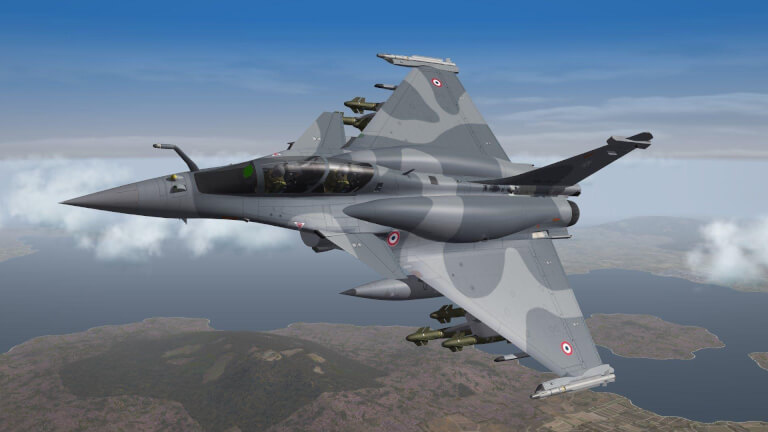
Rafale with conformal fuel tanks, so it can consume even more precious fuel.
Let’s start off by pretending that every single drop of fuel the entire nation produces goes directly into fighter planes, and nothing else. Canada, producing 1 billion lbs of fuel per day makes the calculation easiest. I rounded off the “Super” Hornet’s fuel consumption per sortie, between internal fuel, drop tanks, and occasional mid-air refueling, to about 20,000 lbs. The US F-35, F-22, and Russian SU-35 all have even worse fuel consuption. Fuel consumption numbers for the French Rafale, the Swedish Gripen, and the English/German Eurofighter are all comparable, albeit slightly lower. 20,000 lbs per sortie should be considered a fairly standard number for modern fighters planes, unfortunately.
At 1 billion lbs of fuel produced per day, we can have 50,000 sorties of our imaginary fighter plane, at 20,000 lbs of fuel consumed per sortie. Considering that each of these missions lasts about an hour, we get just 50,000 hours of fighters in the air, at the expense of the entire nations fuel supply.
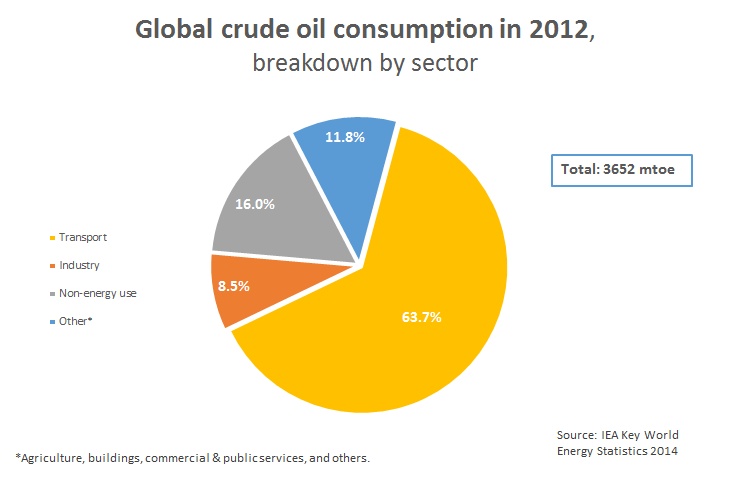
But of course, if every drop of fuel went into fighter planes we wouldn’t have the vehicles we need to drill the oil working properly. Or transport the oil/fuel in the absence of pipelines. Or operate our Warhammer 40k equipment cleverly disguised as mining equipment, which we’ll need for manufacturing.
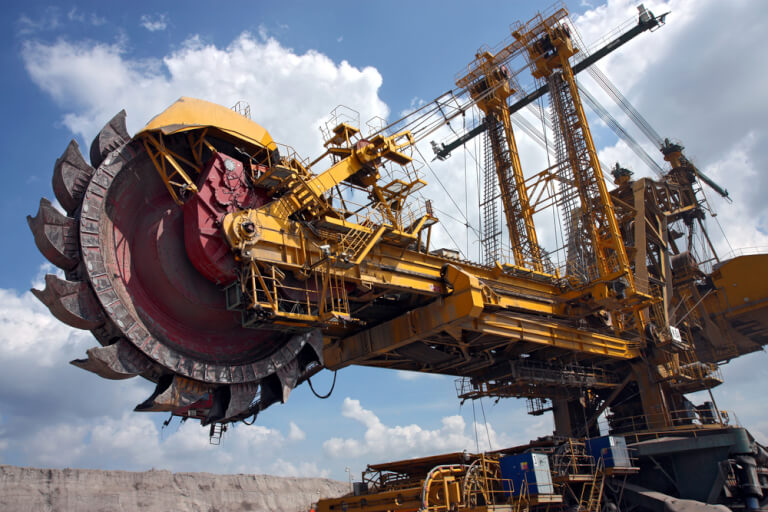
Actual mining equipment. Or is it…
To say nothing of all the other military vehicles we operate that all run on fuel. Aircraft carriers and nuclear submarines have nuclear engines, but everything else guzzles gas. Even if we banned civilians from operating cars, and spent the barest amount of fuel possible maintaining barebones civilian infrastructure, such as transportation of basic necessities and power generation, we still have a huge fuel drain just keeping our civilian population alive.
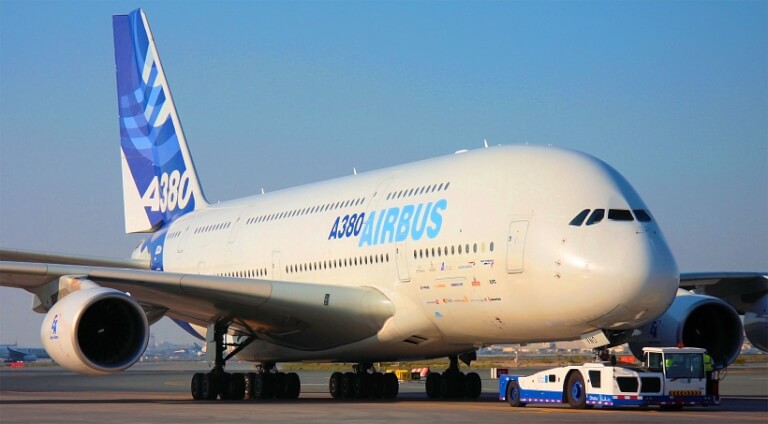
The A380 can consume over 500,000 lbs of fuel in about 15 hours. Shut down during wartime, for multiple reasons even beyond fuel consumption.
Fuel destroying machines like the A380, like all civilian airliners, would of course not be running. We wouldn’t even need to shut them down, as the airliners would stop operating in a warzone through their own volition. But not all civilian infrastructure the uses fuel can be shut down, so what numbers are we talking about here?

The number we are looking for is the barebones fuel consumption of the civilian sector in a wartime economy. Sadly, this information does not exist online in any sort of reasonable format. According to the US Energy Information Administration, 28% of fuel consumption is industrial, with 66% being used for transportation, with the remaining 6% being used in a variety of ways. Not all industrial processes are relevant militarily, but not all transportation is people doing pleasure cruises in their ferarris. Figuring out how precisely how much of each we can shut down is an impossible task with the current information I have. However, we can make some crude guesses.
During the Cold War, which lasted from the 1950s through the 1980s, energy researchers estimate that military operations accounted for only about five percent of primary energy consumption in the Soviet Union and the United States (Pirani, 2018). However, during periods of increased armed conflicts around the world, the same researchers estimate that military-related primary energy consumption in the U.S. climbs to about 15 to 20 percent (Pirani, 2018). Moreover, when looking purely at jet fuel consumption during any given year, nearly one quarter of all global jet fuel consumption is utilized for defense and military purposes (Brown et al, 1991).
If you’re wondering why I didn’t bold that last part, about civilians using 75% of jet fuel which could all go to military vehicles, it’s because it’s irrelevant. Refineries do not have to turn a single barrel of oil into a precise amount of final products. There is no set percentage of Jet A fuel in a barrel of oil, as fundamentally inseperable from diesel fuel. And that’s a good thing, because if there wasn’t, our air force would be even more crippled. Instead we’re going to look at fuel as interchangeable, which, if we control refinement, for all intents and purposes it is.
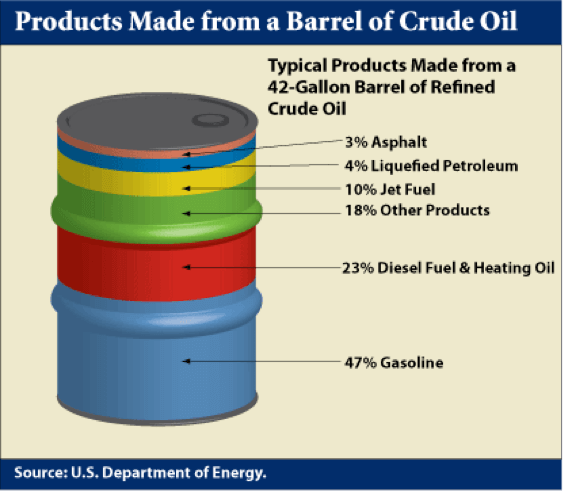
This is the average, not what happens with literally every single barrel.
Currently the US Military consumes around 5% of total US fuel consumption. During wartimes, this has increased up to 20%. However, I’ll be as charitable as possible, and say that in WW3 extreme fuel saving measures can be put on the populace, and the military’s share of fuel consumption can rise to 50% of the total nations output. I’m not sure it was even that high during WW2, but I’m trying to undersell my case here.
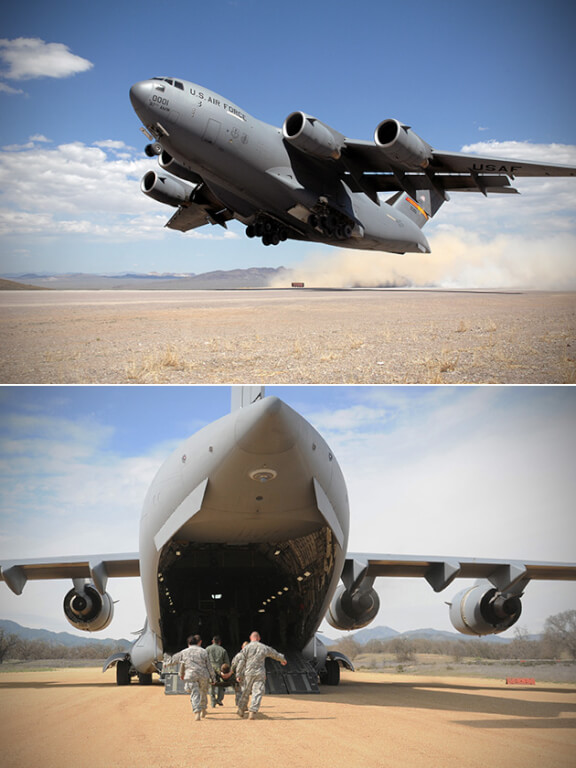
C5 Globemaster. ~350,000 lbs internal fuel.
That 50% of fuel must be shared between all military vehicles, such as the C5 Globemaster cargo plane, which consumes 350,000 lbs of fuel in about 12 hours. Arguably these plane is going to get destroyed by missile strikes while on the ground, and is therefore irrelevant. However, if destroyed that actually increases the fuel consumption of the rest of our logistical vehicles, which must pick up the slack. And it is less fuel economical to transport the 280,000 lbs maximum cargo payload of the C5 through a variety of smaller transports.
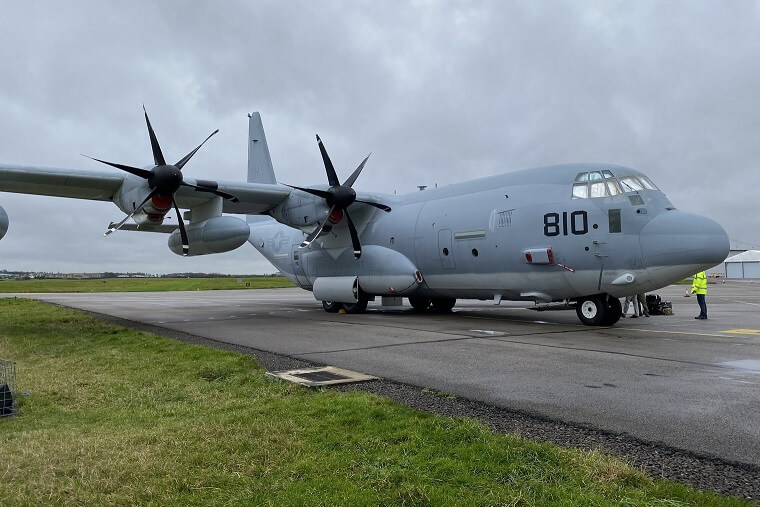
Such as the C-130.
This is especially true for practical reasons. The C5 has a range of over 12,000 km’s, allowing it to fly around the world. The C-130, pictured above, has a range of little more than 3,000 km’s, making it incapable of flying from one side of North America to the other. And it’s entirely possible that the C-130, despite having some very minimal STOL and rough airfield performance, requires airbases that are too vulnerable to long range strikes to operate. In that case, we have to shift down to an even more inefficient system using smaller and smaller STOL planes. Or some combination of land and sea transports.
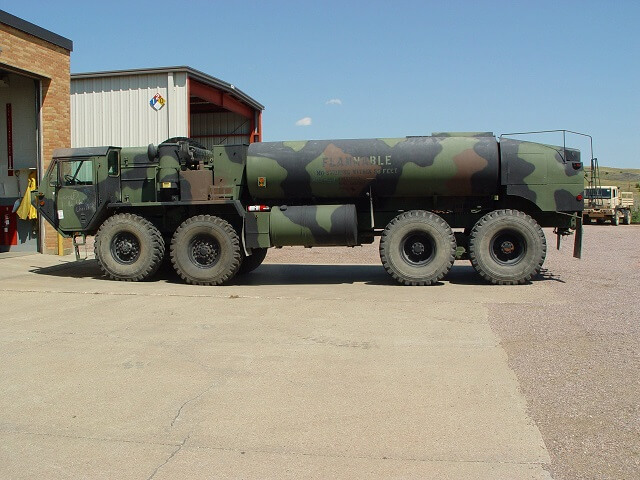
Army tanker truck.
There are many ways to transport the items our military needs, from fuel, to people, to equipment. There are many practical limitations to all of them, but they all need fuel, and quite a lot of fuel. And that’s just our transports. This is to say nothing of all the other fighting vehicles we have.
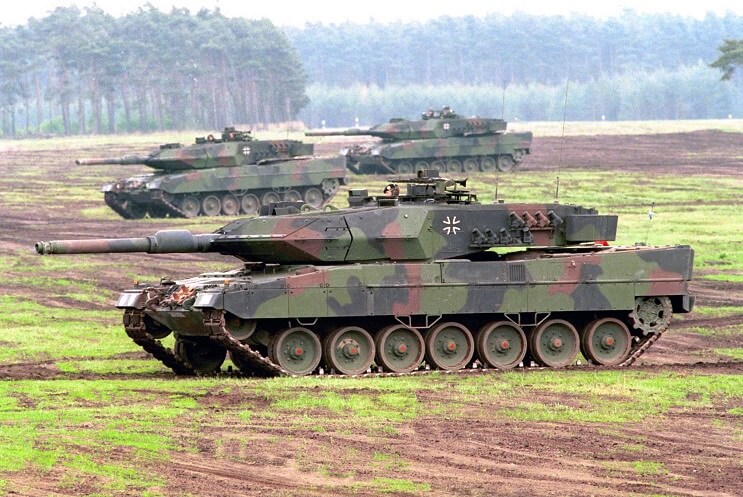
Please sir, may I have another 2,000 lbs of fuel every 24 hours? And for all my buddies?
Calculating the fuel consumption of army fighting vehicles is quite difficult. The tanks, pictured above, can easily consume their internal tanks many times over per day. However, they can also just chill without turning the engine on for weeks. They can be effective in a limited area with wildly varying fuel consumption numbers. That’s actually a very underappreciated aspect of land vehicles, and infantry. They’re very good at being in an area for a very long time without massive logistical requirements, but still accomplishing things.
In any case, calculating fuel consumption for aircraft is almost always far easier.
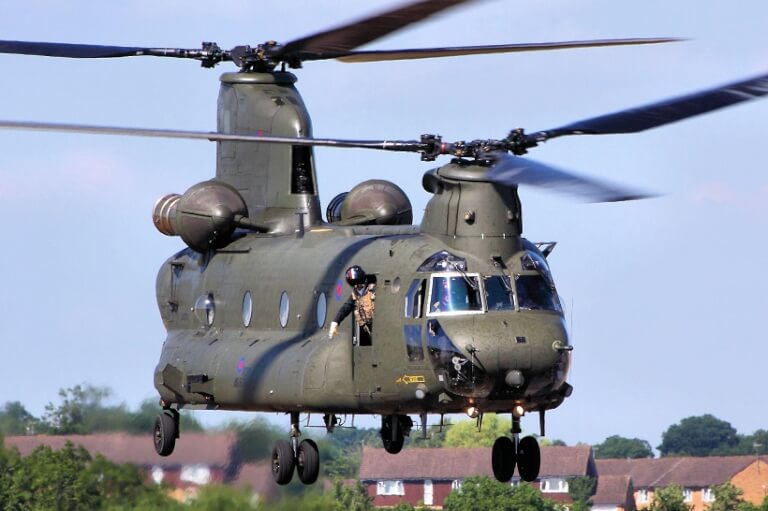
Chinook heli.
And don’t even get me started on helicopter fuel consumption. Not having wings means that helis must generate their weight in thrust as they fly. As a result, they have terrible ranges and payloads, despite consuming disgusting amounts of fuel. The Chinook, pictured above, can carry about 40 troops, or 20,000 lbs in goods, to a maximum combat range of ~350 km. It has about 7,000 lbs of internal fuel, which it consumes in about two to three hours.

Transfer 40 troops by heli just 300 kilometers and you’re looking at a bill for 7,000 lbs of fuel.
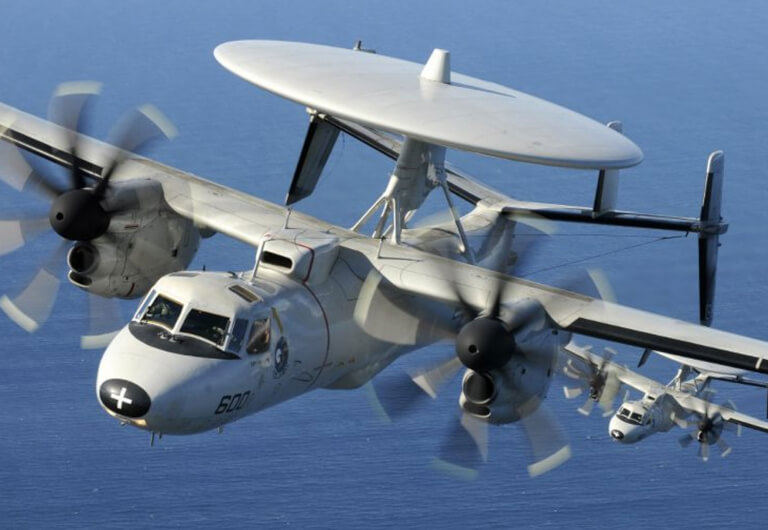
E-2 Hawkeye.
The E-2 Hawkeye, pictured above, is a relatively small AWACS. And it has two 5,000 hp turboprops, which are far more efficient than turbojet engines. Even still, for an endurance of just over 6 hours with maximum fuel, it consumes just over 12,000 lbs of fuel. And you’re going to need lots of these in the air to work in conjunction with your fighters patrolling the skies, as well as looking for surface ships.

Speaking of which, yeah, they consume a fuckload of fuel as well. The AC’s run on nuclear plants, but these retarded things don’t.
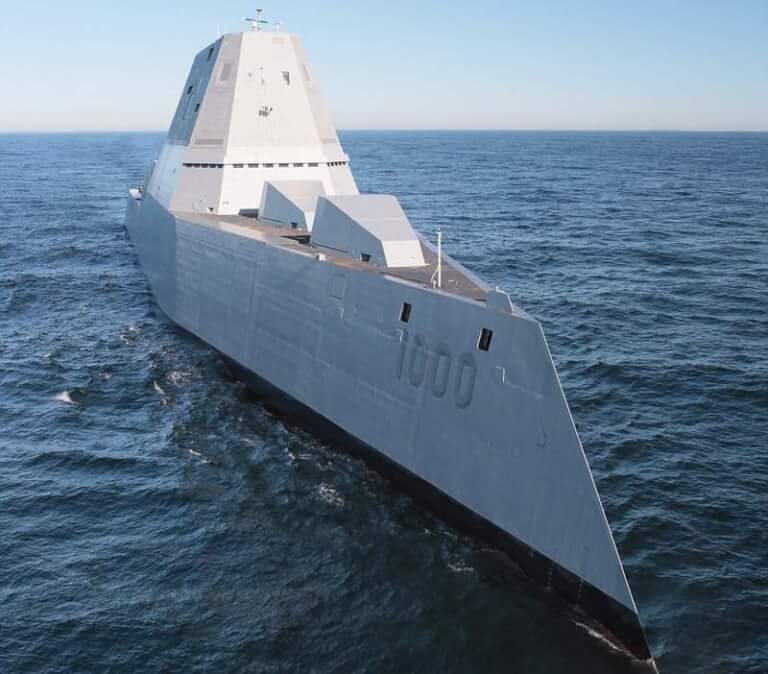
That’s the Zumwalt “destroyer,” a $4.3B ship that can’t actually do anything but pretends to be a thing because of “stealth.” It has two 50,000 hp turbines that produce its thrust. So yes, it doesn’t do anything, but in exchange it consumes plenty of precious fuel.

And not even all of the aircraft carriers have nuclear propulsion. Above is the WASP Class, which is a helicopter carrier. It has two 70,000 hp turbines guzzling fuel, as well as an entire fleet of helis. I can’t find the fuel consumption rates of these ships, or the fleet of aircraft they operate. But needless to say, it’s not pretty.
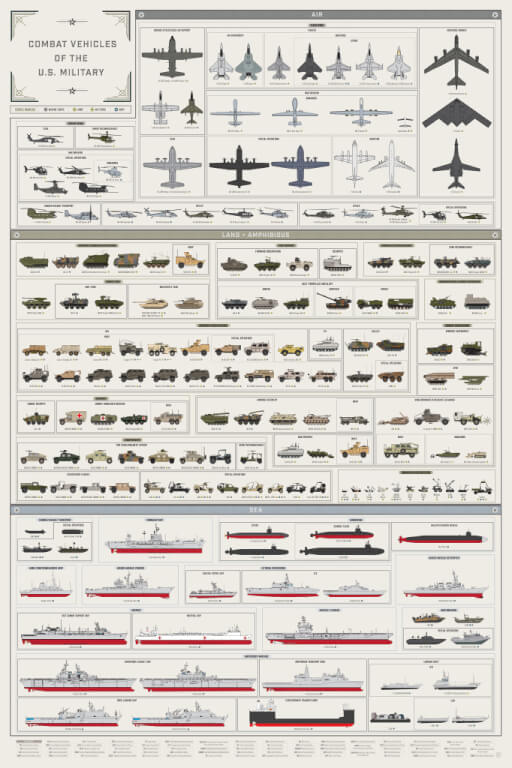
Note the text. This is just combat vehicles.
The list of military vehicles, with just the combat vehicles pictured above, is quite long. All but the aircraft carriers and the nuclear submarines require fuel. And as mentioned earlier, all the planes on the aircraft carrier need good old fashioned fuel. So what percentage of our military’s fuel, which is already crippling civilian quality of life in order to consume 50% of the nations fuel supply, can be dedicated just to fighter planes? 1%? 5%? 10%? Let’s go ahead and propose the proposterous notion that an entire 20% of the military’s fuel supply can go into fighter planes, and nothing but fighter planes.

The other 80% of our fuel has to be shared between AWACS, trucks, cargo planes, our entire surface navy, anti-sub planes, land fighting vehicles, you name it. They all have to share the other 80%. At 20% of the military fuel consumption, and therefore 10% of the entire nations fuel consumption, a number that is laughably optimistic, how many sorties per day can we get with our fighter plane, at 20,000 lbs of fuel per sortie?
Answer: Just 5,000.

And BTW, I actually cheated, because I just assumed that bombers, which are incredibly fuel hungry, are being entirely replaced by long range missiles. To even get to a number that is probably way too high, we are already cutting out entire classes of vehicles. And in return, we still only get just 5,000 sorties/day for Canada, the world’s fourth largest oil producer.

The US isn’t much better, at about 21,000 sorties/day. Russia is at around 13-14k per day. Your world superpowers everyone.

Do you know how many fighter planes the US had in WW2? 60,000. And this wasn’t particularly unique. The Germans had over 35,000 BF-109’s alone, plus over 20,000 FW-190’s. The Soviets produced over 30,000 Yak-3’s. The list goes on. If WW2 fighter planes consumed the atrocious amount of fuel that the modern blimps do, the US military would have been able to fly each fighter just once every three days.

Nowadays they have less than 3,000. And Russia and China combined have just barely more than 3,000. Using our heavily optimistic estimations, the US and Russian militaries might actually be limited by the hilariously tiny size of their fighter fleets, even before they start running into fuel consumption issues. This is of course, simply coping with the fuel limitation by just not having a large fleet in the first place. It’s like this weird thing where you destroy your own fighter fleet before the enemy does and then declare yourself a winner.
Having more fighters that are relatively unused in peacetime is practical for a variety of reasons, not the least of which that if half of them get destroyed on the ground or otherwise at the start of a war it’s not so bad, since you have more than you needed anyway. In other words, the US/Russian Military’s actually have enough fuel for the fighters that they have, they just accomplished that by having fleets that are literally 1/20th the size they were in WW2. 
All militaries are limited by fuel. The USAF simply copes with this by having a tiny fleet of fighters, as opposed to a large fleet that is starved for fuel. The Russian/Chinese/Canadian/Whomever military is no better in this regard. They’ve all coped for the fact that their fighter planes consume hilariously absurd amounts of fuel by simply… having a tiny airforce. A tiny airforce that, I might add, needs to take off and land from pristine airbases that will be getting destroyed in the first hour of WW3.

Less true for the Russians, who made sacrifices in terms of rugged landing gear that enable them to takeoff and land from rough fields.
But even if the airbases were magically shielded from missile strikes, perhaps using some sort of futuristic shielding technology from science fiction, they’d probably still be fuel limited, because I just assumed that in WW3 you can maintain peacetime levels of fuel production. In order to for this to be true, oil drilling, oil transportation, fuel refining, and the transportation of fuel all need to be entirely unimpacted.
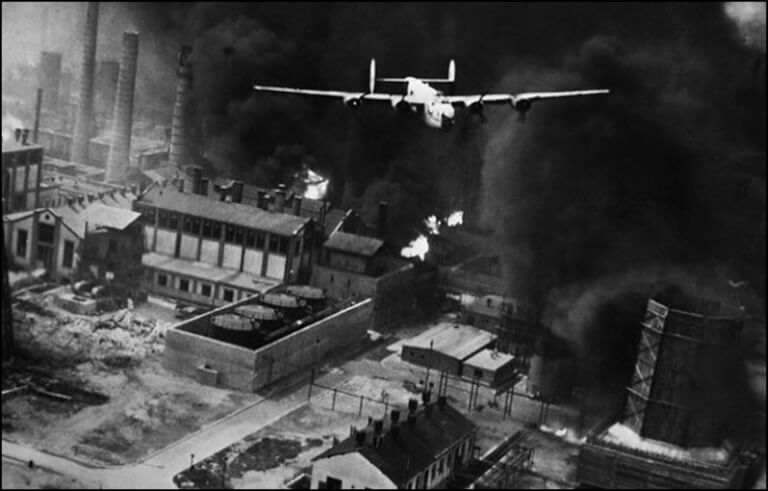
Bombing run on Ploesti oil fields in Romania.
Which is entirely ridiculous. For the exact same reason that airbases are scheduled for the slaughterhouse, being immovable and unhideable targets, most oil extraction operations are the same way. Good luck hiding your deep ocean drilling platforms, which will be easily destroyed by long range missiles at your enemies leisure.

The same is true for large land based oil rigs, and large oil operations more broadly. That leaves us only with tiny little oil wells that can be scattered around everywhere, often produce oil very slowly, and make our fuel production process very inefficient since it is not economical to build pipelines to every tiny little oil derrick in the middle of nowhere.

Look at this little cutie.
So, how much oil can we actually produce if all offshore wells are destroyed, and the large land based operations are also destroyed? According to the US Energy Information Administration, it’s complicated.
The number of producing wells in the United States reached a high of 1,029,588 wells in 2014 and steadily declined to 936,934 wells in 2020—mostly because of lower oil prices and less rig activity (Figure 1). The increase in the share of horizontal wells during the past decade from 4.4% to 16.9% (2010–20) shows the impact of technological change on well type (Figure 2). More than half of U.S. oil and natural gas production comes from wells that produce between 100 barrels of oil equivalent per day (BOE/d) and 3,200 BOE/d (Figures 3 and 4, respectively). The share of U.S. oil and natural gas wells producing less than 15 BOE/d has remained steady at about 80% from 2000 through 2020 (Figure 1).
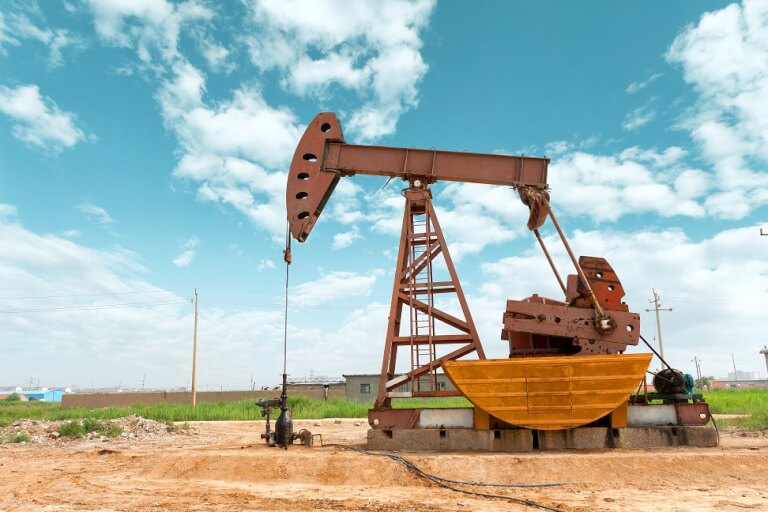
oil well and blue sky
The amount of oil that a well produces per day varies on a lot of things. However, 100 barrels of oil per day is a very productive well indeed, to say nothing of 3,200 barrels per day. These are the large operations I was talking about, that will cease to exist in any serious conflict. Or will they?

The EIA includes this eye opening graph, which shows the total amount of wells sorted by their oil production. The US has more than 200,000 wells that produce less than 1 barrel of oil per day. They have about 800,000 wells producing less than 40 barrels per day. The number of wells that produce over 100 barrels per day, while hard to eyeball from this graph, appears to be somewhere around 50,000 or fewer.
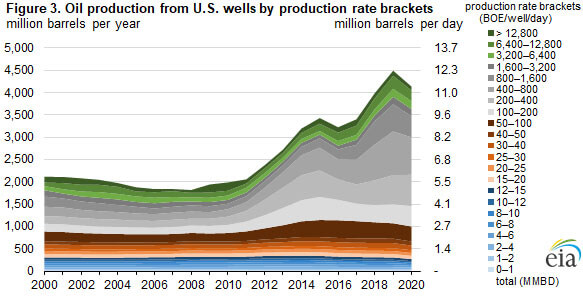
When they said that wells producing between 100-3,200 barrels of oil per day produce more than half of US total oil production, they were underselling it. If all of the sites that produce more than 100 barrels of oil per day are destroyed, than you’re down from about 12.3 MB/D, to about 2.7 MB/D.
While oil wells, due to their exposed nature, are fairly easy targets for bombs, nuclear warheads or otherwise, the sheer number of oil wells provides some protection. It’s pretty much impossible to destroy all million oil wells, what with them being scattered throughout the country. It’s a difficult task to even destroy the roughly 50,000 wells producing 100+ barrels of oil per day.
After doing the math, I was surprised at how resilient oil production really is. There are just so many wells that destroying them all is not realistic. If I had to pick a percentage of oil production that remains even during serious conflict, I might bet lower, but I could go as high as 50%. These are going to need to be from smaller well operations, and they are subject to encirclement, which I’ll get to in a different piece, but destroying the entire oil production with long range missile strikes, if said production comes from land, is not feasible.
However, unlike large wells which sometimes have pipeline access, the smaller wells have to store and then, after an efficient build up, manually transfer the crude oil to the destination refinery. As a result, they require an intact road system to operate, which may or may not be the case.
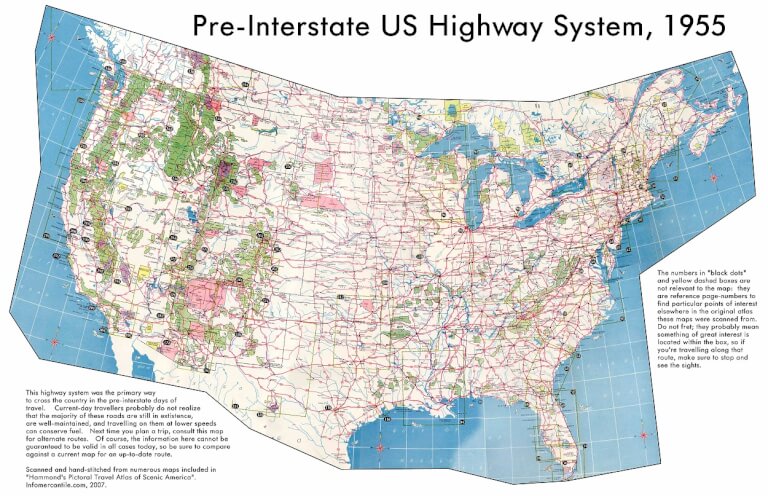
The intactness of the road system is quite difficult to estimate. Bombing can make roads unusable. Infantry patrols can ambush and destroy cargo vehicles. CAS planes, not even A-10’s, far smaller even than that, can effectively deny movement of cargo entirely. However, these small wells should probably not be located thousands of miles away from refineries. If they are, they need to be connected through a pipeline system, which must be built in peacetime and is practically infeasible to build for the hundreds of thousands of small, relatively unproductive wells.
The crude takeaway, no pun intended, is that road systems are rugged enough that, unless the invading military is controlling the area they operate in, it shouldn’t be overly hard to get the crude oil to the refineries themselves.

Which, if they are as large as this one, are going to be getting blown up with long range missiles.
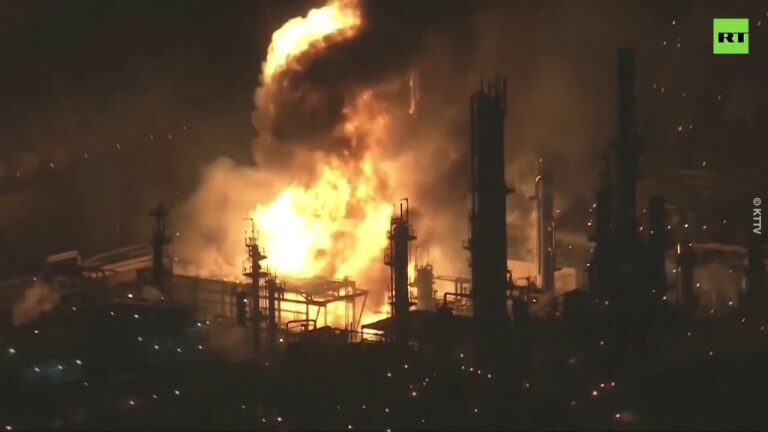
Above is a picture of a Californian refinery experiencing a fire, not a missile strike, but the idea remains the same. The largest refineries in the US, again according to the EIA, consume over 500,000 barrels of oil per day. 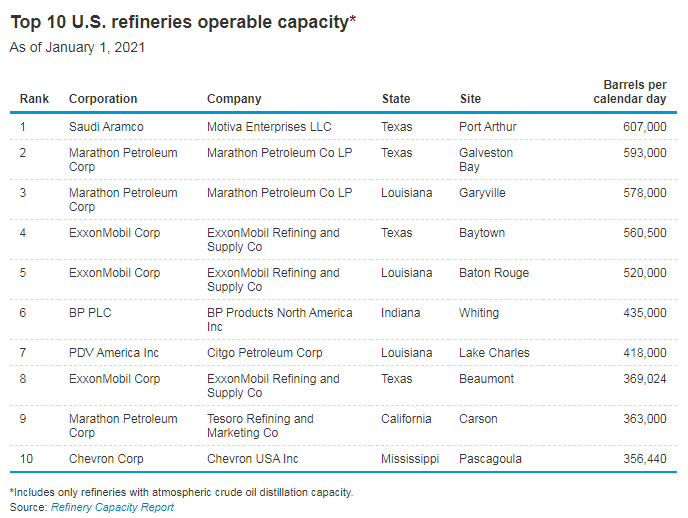
NOTE: Technically refineries are measured in barrels of product per day. Products from a barrel of oil can actually be larger than the oil itself, due to additives. However, these figures are comparable, so I use them interchangeably for the rest of this analysis.
As you can probably tell, there is an enormous well/refinery mismatch in terms of numbers. These ten refineries combine for about 4.8M barrels of oil refined per day. That’s almost a third of the entire US oil production. All located in gigantic, easily destroyed sites.

Irving Oil Refinery, New Brunswick.
This is the largest Canadian refinery, the Irving Oil refinery in New Brunswick. It is actually slightly smaller than the ten US refineries mentioned previously, refining about 320k barrels of oil per day.

Refinery in Burnaby, BC. 55k bpd.
Above is the refinery in Burnaby, British Columbia, which refines only about 55k barrels per day. As you can tell simply by looking at it, it is also impossible to hide and operate in a serious conflict. Once again, using the EIA as our resource, we see that the US cumulatively operates just 129 refineries. While it was not practically possible to destroy all million wells, and even taking out the biggest ones has limited upside, it is absolutely possible to utterly cripple US fuel production by taking out the refineries. In case you are wondering, there are similar numbers for Canada, which has just 15 refineries.
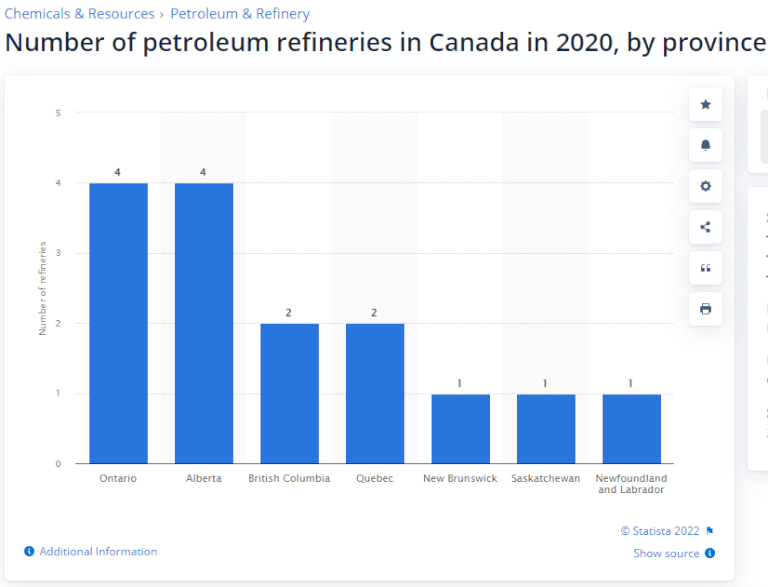
It is not economical to build thousands of tiny little refineries, especially if not connected through a pipeline system. So countries don’t do that, and then LARP like they’re going to get any fuel production during wartime. They won’t.

Lusk Refinery, Wyoming.
Above we see the Lusk Refinery, in Wyoming. It is the Guinness Book World Record Holder for “World’s Smallest Refinery.” It produces just 190 barrels of fuel per day, which works out to a bit less than 50k pounds of fuel produced per day.
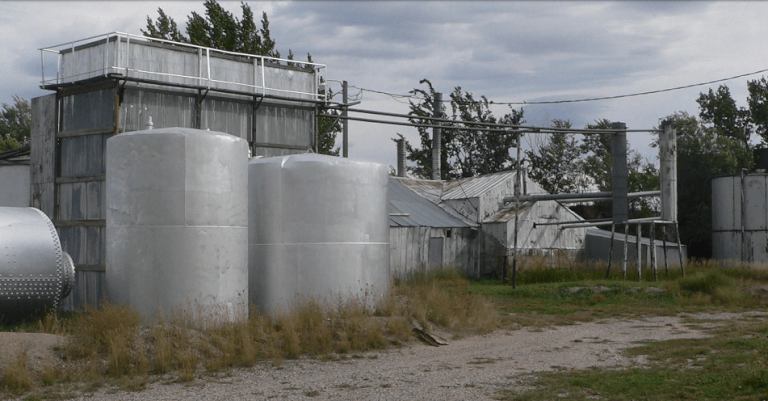
This is the size of refinery you need to support an F-18 Shitty Hornet or F-35 flying for just two and a half hours per day.

But Lusk is a historical site. The smallest active refinery in the US is in North Dakota, and goes through 20k barrels per day.

North Dakota Refinery. 20k b/d.
As you can see, it is still not particularly small.
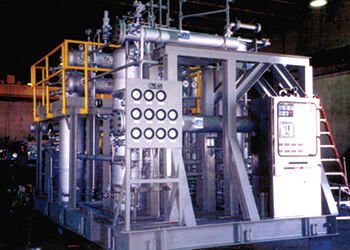
Tiny refining machinery.
Of course, there is no physical limitation to tiny refineries. Refineries used to be a lot smaller. Instead, economies of scale, absent military intervention, pushed the size of modern refineries to absolutely gigantic scales.
OGN News: (You need to sign up to read that directly)
But now – and for a number of quite different reasons – their time appears to have come in a number of diverse parts of the world including, perhaps surprisingly, in the US. Unrest in the strife torn areas of the Middle East and Africa effectively rule out the building of plants that can easily cost over $10 billion apiece and mini-refineries are increasingly seen as the answer to shortages of basic fuel requirements like petrol, kerosene and other refined products.
Modular mini-refineries (which can be as small as 1,000 bpd nameplate capacity) typically have the advantage of being located close to their source of crude oil, thus minimising logistics and distribution costs. Plant modules can also be joined together to create a much larger refinery of 100,000 bpd or more, should demand dictate. This approach has already been successfully applied in locations such as Kurdistan, Indonesia, West Africa and West Siberia.
Another attraction is that mini-refineries are cheap and quick to build.
Such is the case in the parts of Syria and Iraq that are controlled by Islamic State (ISIS) and where the existence of rebel-held mini-refineries is thought by some to have lengthened the conflict. At its height, ISIS was believed to control up to 30 mini-refineries.

Above is what a 1,000 BPD plant looks like. Needless to say, it is still not exactly tiny. There comes a certain point where the refinery gets small enough that they can be practically hidden, at least to some extent. After all, remember the camouflaged Lockheed plant from WW2 that I mentioned in the previous piece?
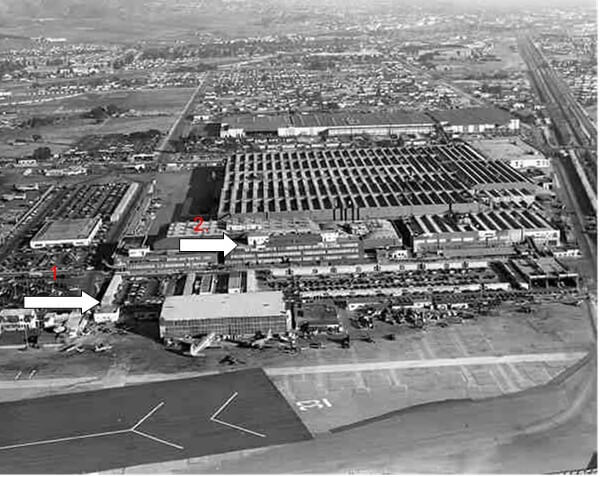
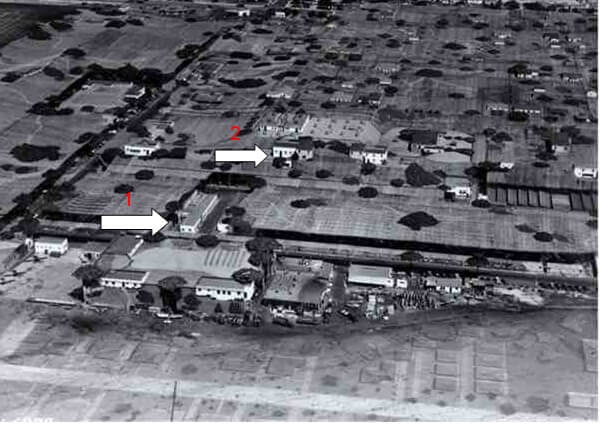
That’s a little extreme, and you would need to do this before building the plant. Beyond that, refineries produce smoke and heat, which can be difficult to disguise, and tend to have relatively skinny and tall buildings, which also make things a bit more difficult. There is also the practical aspect that if you have tons of trucks moving to and fro the area it will become fairly obvious that something important is happening there. As hard as I was on spy satellites in the previous piece, that is exactly the kind of thing they are good for.
So frankly, even an average refinery size of 1,000 BPD might be larger than we can reasonably get away with, practically speaking. As you decrease the size of the refinery, you increase the logistical complications, and decrease the overall efficiency. However, in addition to being able to disguise the construction and operation of these refineries, you just flat out have more of them.
The sheer number of US oil wells, at about a million, makes them practically impossible to completely destroy with missiles. The same is true for refineries. Canada, as a net oil exporter, does not refine all 4+ million barrels of oil produced per day. We export about 2.85 million of the roughly 4.2 million barrels of oil produced per day. The 2.85 million barrels refined are done so at the 15 refineries mentioned earlier. But let’s say that we wanted to refine all 4 million barrels of oil and use it for ourselves. In that case, at current average refinery capacity, we would need about 21 refineries.

Pictured: Back down to 20 refineries.
These are getting destroyed the same as our concrete airbases. And honestly, nuclear warheads are somewhat irrelevant for this purpose. Conventional weapons will do just fine.
In contrast, if we have a bunch of very small refineries, consuming around 1,000 BPD of oil, and producing around 250,000 lbs of fuel for each of them, we need to have 4,000 refineries, each of which we can more reasonably attempt to hide, just like the Lockheed plant from WW2. If 21 of our gigantic refineries are destroyed, we have zero refineries. If 21 of our tiny refineries are destroyed, we have 3,979. Just like with oil wells, having lots of them makes them more and more resilient to destruction.
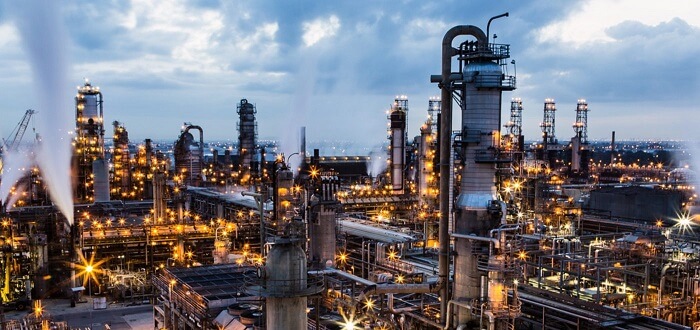
I do love how steampunk the refineries look.
You can even keep the large, economical refineries for peacetime usage. After all, they are so large because it is economical to be that large. The construction of thousands of tiny refineries is quite the military project, but it’s also exactly the type of thing that militaries should actually be doing. Along with a series of pipelines that enable even more efficient usage of these refineries.

I am not exaggerating when I say that the US Military has precisely zero ability to wage any sort of long, sustained war against a “peer” adversary. It’s possible that they have built thousands of redundant refineries in secret, but I’d bet my left nut that they haven’t. As it currently stands, the ability for the nation to produce fuel in the middle of WW3, or any sort of serious war, is precisely zero. I did this bit before, but it’s time for another Contradictions of the Military Industrial Complex Bullshit Factory.
- Long range missiles, nuclear warheads or otherwise, can be fired from distances of hundreds, or even thousands of kilometers. They can be launched from land, sea, or air. In the case of ICBM’s, they can travel all the way across the world, and land in a 350m radius of the target, with 90% accuracy. Anything that can be found can be destroyed.
- Relying on a tiny number of gigantic fuel refineries is something a serious military does.

In any real war US refineries would be getting destroyed pronto. Because the US military would literally get zero fuel, making the amount of fighter sorties they could support per day be also zero, the total amount of sorties per day is irrelevant. The only thing that matters is the total amount of fuel already existing at these airbases. Except that those airbases are being destroyed anyway.

The very start of this piece, so many thousands of words ago, I asked if it truly was possible for the US Aircraft Carriers to get resupplied every four days with another 21 million pounds of aviation fuel. Here we see that the answer is a resounding no. They aren’t getting any more fuel, because the refineries that produce said fuel are going to have been blown to smithereens. To say nothing of the naval bases that are congregating the fuel for transport.

But this article series is called “Modern Fighter Planes are Jokes,” not “Modern Militaries are Jokes.” So let’s go ahead and ignore current material reality, and hypothesize what sort of fuel production we could expect from an actually competent, and serious military that took steps to protect its oil/fuel delivery from long range missile attack, using the strategies laid out previously.
The truth is, since we can build our tiny refineries in peacetime, we can massively overproduce them. The only realistic issue is simply cost to the taxpayers. The largest refinery in the world is owned by Reliance in Jamnagar, India. It has a capacity of 1.24 Mbpd, and cost about $6bn to build. However, I’ve seen other sources that estimate the cost of building a 500 Kbpd refinery to be about $10B, at least in the US. If our small refineries could be built to the same cost/production ratio, we would need to spend $20B for every million barrels of oil refined per day. Scale that up to the entire US oil production of about 16 Mbpd, and you have a project that costs $320B dollars. Or in other words, less than a third of the war budget for a single year.
Even if you doubled the construction price this is not exactly the Moon Landing, especially since the cost would be spread out over multiple years. A robust, overly redundant system where we build more refineries than we need, and build them under camoflage, could probably sustain fuel production pretty well. It’s entirely possible you could go from a situation, now, where you get zero fuel, to not being refinery limited at all.
I’ll go ahead and say that, whatever amount of oil we can produce, between road destruction, refinery destruction, and the decreased fuel economy of the entire system over large and fragile but economical refineries, and we’re losing another half of our total fuel production. If the enemy entirely controls the low altitude skies, or has their army in the area, this gets cut down to essentially zero, but that’s a different story.

F-14. Famous from Top Gun. Actually really sucks.
We are finally back to calculating how many fighter plane sorties we can sustainably support. The answer with our current setup, with our refineries getting trivially easily destroyed, is zero. I mean our airbases were also destroyed, so it doesn’t really matter anyway.
Instead, assuming a serious military, with fighters designed to take off and land from rugged, unprepared airfields, and a system of thousands of hidden, tiny refineries, I think the most we could reasonably expect would be something like one quarter our original fuel production. In that case, Canada would go from 1B lbs of fuel per day, to 250M. And for the US, it’s to just a little over 1B lbs.
So, to recap. We calculated that the absolute highest percentage of our nations fuel that the fighter planes can consume is 10%. This is 20% of the entire military fuel supply. Then we concluded that the total percent of our fuel supply that we can actually produce in the middle of a serious war, assuming the foresite and actions of a serious military, is 25%. Add the two numbers together, and our hard limiter for the amount of fighter sorties we can operate in the middle of WW3 is 2.5% of our total peacetime fuel supply. And all of that simply ignores the very serious logistical problems we have getting the fuel from the refineries and into the tanks of our fighter planes. This would require a system of pipelines, or an intact road system.
Even with all that, the absolute maximum number of sorties we could support in Canada, with a gas guzzling blimp “fighter” plane, would therefore be about 1,250 per day.

You can take those numbers and multiply them by about four and a half for the US, or just less than three for Russia.

Absolutely pathetic.

So you might be asking, “can’t we just have a fighter plane that uses less fuel.” Well yes we can, but there are two reasons why the jet fighters consume so much dinosaur fuel. One of those reasons is very good. The other is complete bullshit.

Here is the valid reason why we need them to consume so much fuel. In order to fly at high speeds, these planes need turbojet engines. Technically the modern ones are ultra low bypass turbofans, but it is effectively the same thing.
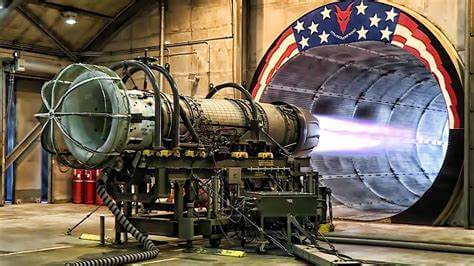
These engines are the least fuel efficient engines in the known universe. But worse than that, we can’t simply give the fighters small engines, since they also need a high T/W ratio to fight against each other. We’ll go over this more in the tactics piece, but suffice to say, it’s not really optional. We need a huge amount of thrust to be generated very inefficiently.
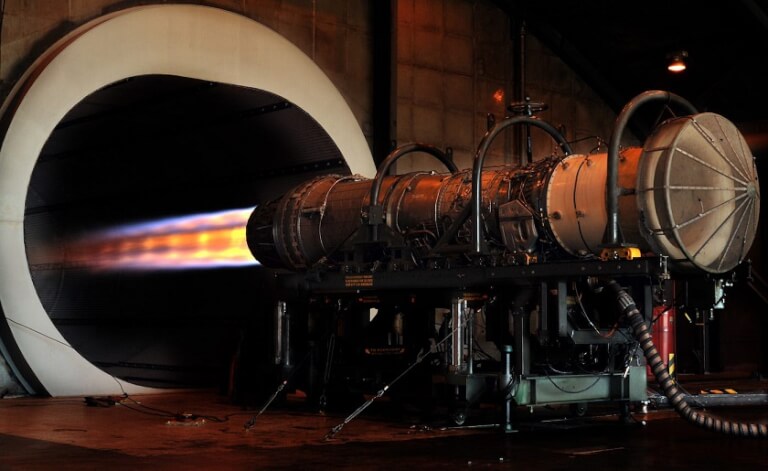
There are three other types of airplane engines. Piston props, turboprops, and (high bypass) turbofans. You’ll see the first on small civilian airplanes, the second on large civilian planes, small passenger airliners, and some small military planes, and the third on large passenger airliners and some large military cargo or AWACS type planes.
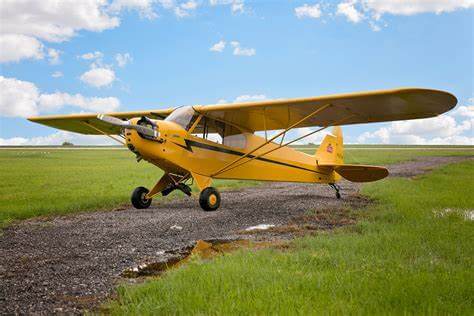
A cute little Piper Cub. Piston prop engine.
While prop aircraft technically do not produce thrust directly, instead horsepower, the amount of thrust they produce in pounds, at sea level with reasonable temperatures, is typically about 3x the horsepower. The efficiency of the propeller drops off the faster we move through the air, and the higher the altitude. This is why the fuel efficiency of a turboprop, or piston prop airplane at supersonic speeds is zero. They simply cannot produce any thrust as they travel that fast, or even at high subsonic speeds.

The propeller gets less and less efficient with speed, and tops out around 850 kmph maximum, with rapid loss of efficiency long before that. Passenger airliners use medium bypass turbofans exposed directly to the air, as this provides good thrust, moderately low drag, low noise, and acceptable fuel economy.

Medium bypass turbofans on the wings.
But supersonic planes need turbojets. Nowadays that’s just fighters, but that was also true of the Concorde.

Which used turbojet engines. And not actually the ultra-low bypass turbofans. Straight up turbojets.
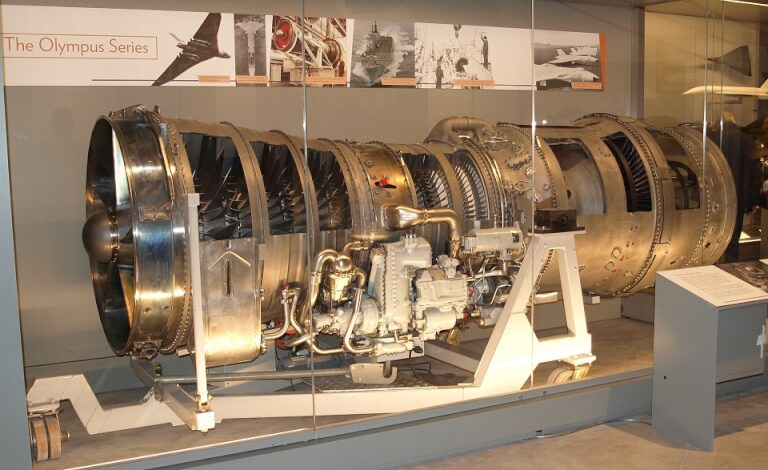
Concorde Engine. 70,000 lbs of thrust with afterburners on.
Piston props are the most efficient, followed by turboprops, then turbofans, and finally turboprops. Before I tell you how much more efficient piston props are when compared to turbojets, just take a minute and try to guess. Is it 10% more efficient? 35%? Maybe even twice as efficient? That’d surely be a lot, right?

Piston propeller engines are, at sea level and zero velocity, about six times more fuel efficient than turbojet engines. That is to say that for the same amount of thrust produced, they consume one sixth the amount of fuel.

Yes, you read that right. And turboprops are about 4-5x more efficient themselves, with turbofans somewhere in between them and turbojets.
NOTE: If you’re curious, you can find realistic numbers here. Converting metric units to Imperial is a bitch, but to get to the point, the SFC of small piston prop engines is often around 0.15 or even lower (lower is better), measured in the same units we will be using later. Turboprops actually get better efficiency as they get larger, in contrast to piston engines, but never quite cross over to having quite the efficiency of the piston props. You can think of them having somewhere between 0.15-0.2 SFC. Remember that for later.
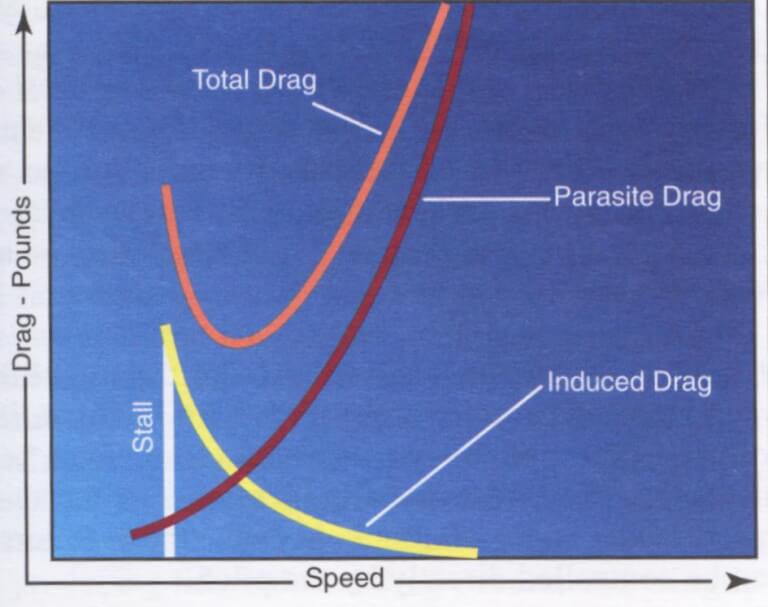
Induced drag comes from the wings generating lift.
Fighters have extreme drag requirements. Parasitical drag grows exponentially as speed increases, typically with the square of the velocity increase. If you are flying twice as fast, you are experiencing four times the drag. So even if we wanted to, we could not put a higher bypass fan inside the jet, since there is simply no room.

Although all the hanging munitions make this a draggy boy, so he’s not the best example.
We need tons of thrust to overcome the drag at high speeds, coupled with a sleek body. That means a turbojet engine on the inside, which drains fuel like Mexican Ladyboys drain Lindsay Graham‘s balls through sexual humiliation.
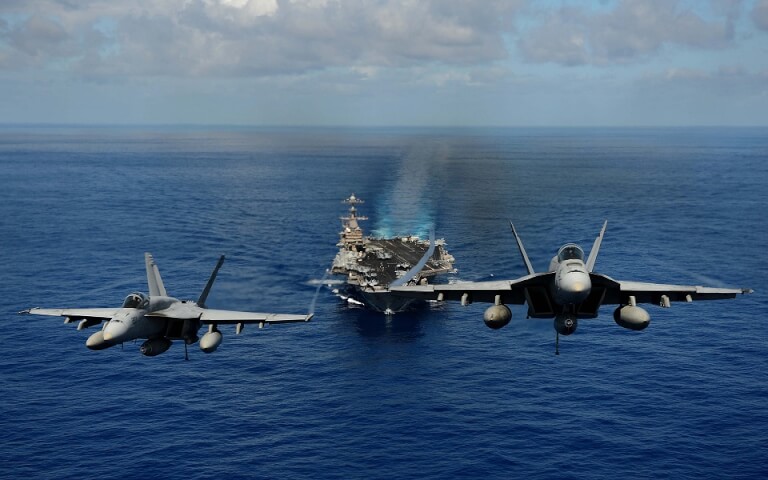
The concept of Specific Fuel Consumption measures exactly this. If we want to produce a single pound of thrust consistently for an entire hour, how many pounds of fuel do we need to consume? If the answer is 1, we have an SFC of 1. Lower is better, with an SFC of 0.5 being twice as good. So what’s the SFC of these modern fighter jet engines? It’s about 0.8. And yet, the Thrust to Weight ratios in these planes is close to 1:1, sometimes more.
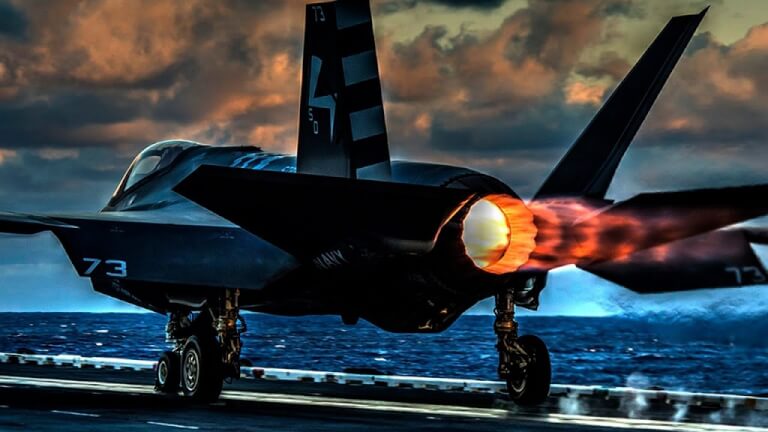
I hope the implications of this have set in. You have a plane, with an engine capable of producing the weight of the plane in thrust. But if it did so for an hour, it would need to consume 80% of the weight of the plane in fuel.

It’s actually way worse than that if the afterburner is on, because the SFC number is for dry thrust. Typically the dry thrust will be roughly 2/3rds of total thrust, with the afterburner providing the rest. The afterburner fuel efficiency, or I suppose I should say, fuel inefficiency is 3x worse than the dry thrust.

F-16 with conformal fuel tanks.
Above we see some Turkish F-16’s with conformal fuel tanks. Those ruin the aerodynamic profile of the plane, and yet they still have them. This is because the F-16’s internal fuel capacity of 7,000 pounds is going to get disappeared like Hillary Clinton’s enemies by that F100 engine, producing almost 18,000 pounds of dry thrust. If the engine is at full throttle, again, not including afterburners, that 7,000 lbs of fuel will be gone in just 29 minutes and 10 seconds.

And if we also added in the roughly 11,000 lbs of afterburner thrust, at an estimated SFC of just 2.4, we’ll blow through all of our fuel in just 10 minutes and 17 seconds.

Yes that’s right. If you took an F-16, loaded it up with 7,000 lbs of internal fuel, and chained it down, you could drain all 7,000 lbs of fuel in just 10 minutes with the afterburner on. While the F-16 is known for being an underfueled fighter, the same principle holds for pretty much all of these planes, especially the American ones.
The Russian SU-35, with a fuel fraction of over 40%, has by far the best endurance of any fighter plane, at least considering only internal fuel. It drains its 25,400 lbs of internal fuel in 49 minutes on full dry thrust, and 18 minutes with full afterburner. So you know, it can pretty much go all day.

When I first heard a retired fighter pilot talking about how they could only fight for three or four minutes maximum in the combat zone I thought I misheard him. But no, these engines, especially afterburner on, consume such jaw droppingly awful quantities of fuel that the planes have no real endurance to speak of.
Making matters worse, turbine engines have poor partial load efficiency. Piston engines trap the air that they compress in a theoretically entirely sealed vaccum. Turbines need to compress the air a little differently. Even when running at full power, they are typically about 60-70% as efficient as piston engines. However, when running them at lower power, they still need to run their compressors just as hard, unlike a piston engine, which can simply run at a lower RPM.
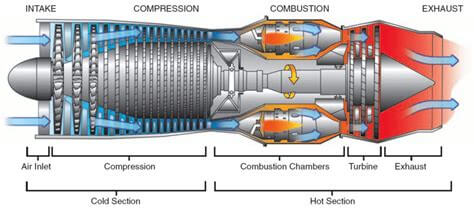
Turbine engine diagram.
I’ve heard figures of 40% fuel consumption at just 25% thrust for these engines. Unfortunately, I can’t find the exact numbers out there, but suffice to say there is a practical lower limit to how hard we can crank back on the thrust generated by a turbojet. If we could run these engines at just 40% of dry fuel consumption and never touch the afterburners, that still gives us a grand total of around 1:12:30 running time. A little more than an hour of running at 25% dry thrust and all of our internal fuel is gone. Do any actual fighting with the afterburner on, or cruise at a higher speed, and you can drop that down even lower.

F-16 with large drop tanks under each wing.
This is why the Turks, and many other customer countries, bought conformal fuel tanks for their F-16’s, despite the aero penalty. It’s also why fighters often, possibly even usually, fly with drop tanks. A drop tank is a fuel tank that is attached to the aircraft, burned first, before internal fuel, and then jettisoned.
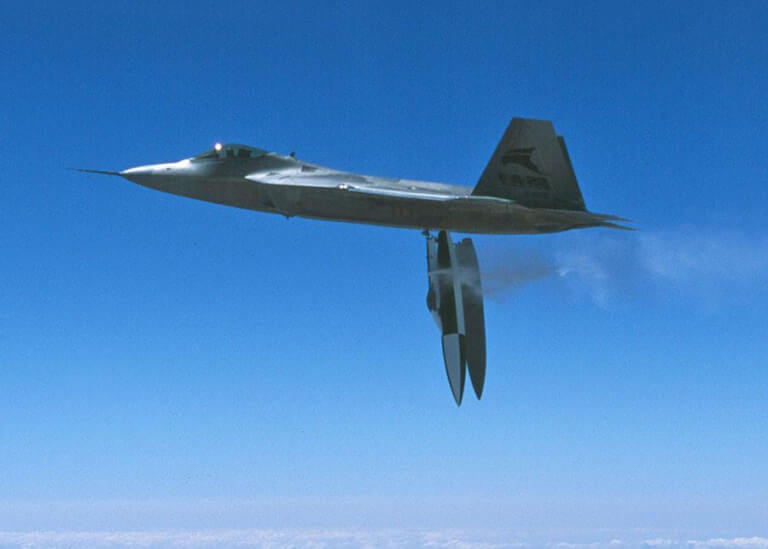
F-22 jettisoning drop tanks.
The advantage of this is obvious. Your planes have garbage range and endurance on internal fuel, so you take these drop tanks along to give you an extra 50% or so fuel. The drawbacks should also be obvious. The drag of the plane is increased with them on, which makes the planes even more fuel inefficient, even if they now have more fuel to be inefficient with. You also need to now manufacture some huge amount of drop tanks for every fighter plane, since they could theoretically be dropping them every time they fly. And if they aren’t dropping them, then they pay the fuel economy hit that the extra drag provides for their entire mission.

And while this partially solves the individual jet fighters horrible range and endurance problem, it doesn’t make them use less fuel, but rather, due to increased drag, slightly more. While drop tanks are very much worth it, this exacerbates the strain on the nations precious fuel supply from our fighter planes even more.

There is simply no way to get around this fundamental limitation of turbojet engines. However, there is a way to mitigate these problems, that arguably makes the planes tactically better anyway, but definitely makes the planes better strategically and operationally. It’s called:
Make the plane smaller you fucking idiot.

While you can potentially give a plane a slightly smaller engine, or possibly improve drag here or there, it’s impossible to fundamentally change the design of a fighter without making massive sacrifices to the aerodynamic performance. While the engineers who design these planes should obsess over every last little percentage improvement they can eke out of the design, that’s as impossible as it is irrelevant for anyone who isn’t part of an actual design team. However, there is one area where we can make not single digit improvements to our fighter, but possibly improvements of an order of magnitude. And that’s called not letting parasitical bureaucracies blimp up the size of our planes.

1948’s F-86 Sabre.
Here is the F86 Sabre. Designed just after WW2 and first flying in 1948, it is arguably the greatest fighter plane the US military ever made, when looked at relative to its contemporaries. It weighed about 16,000 lbs in typical configuration, with about 3,200 lbs of internal fuel, and up to 1,400 lbs in drop tanks. That’s less than 5,000 lbs total, which, you may have realized, is less than 1/4 what our obese “fighter” planes consume per mission these days. While there is no reason to build this plane specifically, a fleet of F-86’s could be 4x larger than the typical modern “fighter” plane.

Here we see the English Folland Gnat. It weighed less than 5,000 lbs empty, and less than 9,000 lbs in its heaviest configurations. The internal fuel capacity was about 1,500 lbs, with a maximum fuel configuration coming with multiple drop tanks, and weighing in at about 3,000 lbs. While there is no reason to build the Folland Gnat specifically, a fleet of them could outnumber our modern “fighter” planes almost 7:1 in the skies.

Folland Gnat in front of Mig 25 Foxbat.
If our fighter planes consume half as much fuel, we get twice the amount of sorties out of them. If they consume 1/10th the amount of fuel, we get 10x the sorties from them. While we can possibly thieve some fuel from our other military vehicles, if you’ve gotten to this point in the article you know how crippling that would be. Our fighters are already using 20% of the militaries entire fuel supply, and 10% of the entire country. We can’t just have planes that use double the amount of fuel, while still flying just as often. Let alone 7x more fuel. It truly is a tradeoff between fuel consumption and fleet size.

You could be forgiven for thinking that there is some sort of technology that makes these modern “fighters” bigger, but the opposite is true. There are lots of modern advances, most importantly carbon fiber composites, that push the weight of aircraft down.

Carbon fiber composites are estimated to be able to save up to 20% of the entire airframes weight, but there are plenty of other technological improvements that help save weight on our planes. Computer assisted fly by wire flight controls allow us to have dynamically unstable planes, used on all modern fighters since the F-16. This is extremely useful for decreasing drag, but maybe more importantly allows us to use different, more efficient and flexible designs, such as the close coupled canards we see on some of the Euro fighters which were impossible before fly by wire. These designs, among other things, help us shove more fuel inside the plane, or the same amount of fuel in a smaller plane, due to increased efficiency of wing fuel tanks with the large internal area.

Canard design on the Rafale followed by a cropped delta.
We’ve also slowly improved our understanding of aerodynamics. Not only that, but the tools used to build these planes, both in manufacturing and design. So for the same drag performance, and therefore same speed for the amount of thrust, we should be getting smaller planes that consume less fuel.
The engines we have these days are better in every way, even if only by 10-20% over late 50’s engines. Since speed requires exponential thrust, the same speed can be achieved with a smaller, modern engine that produces the same amount of thrust. Saving weight, or allowing more fuel, or giving us some other benefit.
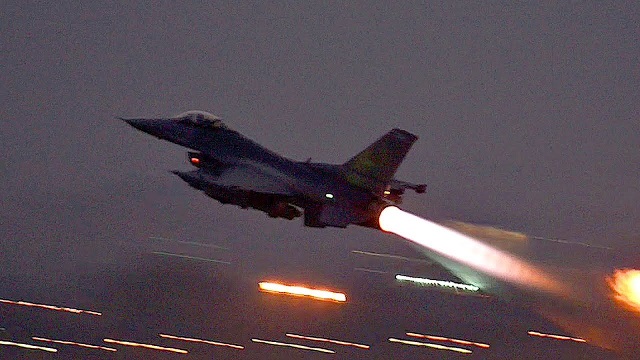
Although let’s maybe avoid the afterburners.
Maybe just as importantly, albeit more nebulous, we have plenty of decades of experience theoretically narrowing in on the best designs. One example I gave earlier, the canard delta’s seen on the European Fighters take full advantage of relaxed static stability, providing strong structural strength while also allowing us to shove lots of fuel inside, which should help us avoid ever having to strap on conformal fuel tanks.

The Folland Gnat dates back to 1959. Above is Ferrari’s F1 car from 1959.

Above is their car from 1970.

And here is their car from 2022. One only needs take a quick look at the car to see how much more sophisticated of a design it is. F1 cars are regulated to have a minimum weight, but even so they were among the first to embrace carbon fiber chassis in the mid 80’s, just so that they could spend that weight in more appropriate places, like the engine. That’s what actual competition brings, technological improvement that is actually relevant.

F-111. Arguably the shittiest “fighter” plane of all time.
I brought up F1 cars, because F1 cars have to directly compete against other F1 cars. There’s no disguising a poor performing car by bloviating about “stealth” characteristics, or “muh AESA radar.” You can’t LARP like an F1 car is “multirole,” to explain why it’s getting lapped many times over in a race, by pretending that it’s secretly also a cargo truck. It’s real competition, the likes of which our parasitical military bureaucracies hate with a passion.
That’s why the Canadian Air Force “leadership,” tried their hardest to kill the competitive fly off scheduled for our fighter plane program. That’s why Joffrey Trudeau, who literally ran on doing said competitive fly off, decided to… not do that and instead buy the F-18 Super Hornet. Any serious competition that these planes are exposed to would destroy much of the bullshit premises that are used to justify their bloated sizes and price tags.

You may be thinking that the reasons for fighter planes blimping up in size have to do with “energy maneuverability,” “multi-sensor situational awareness,” “First site, first kill,” “fifth generation fighter characteristics,” or any number of talking points that you might see repeated online or even by your least favourite politician. The reality is just that bigger planes can have more highly profitable garbage shoved into them, and because aerodynamic performance can be bullshitted in lots of different ways and is poorly understood by most people they can get away with LARPing like they still have a competitive fighter jet, somehow.
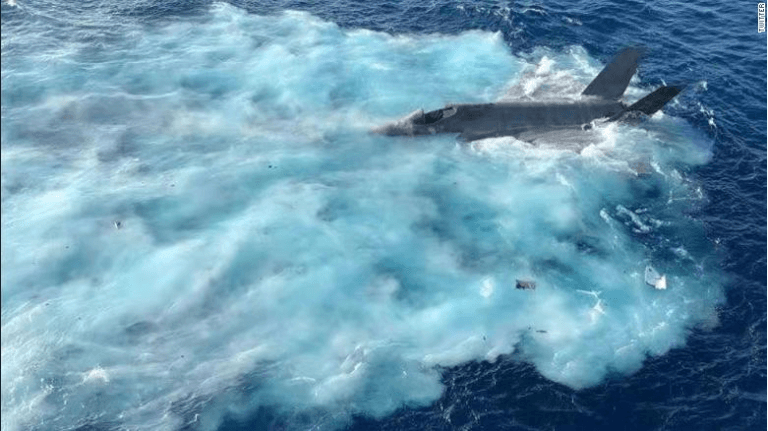
To give one explanation. There are a few different ways to make a plane fast. One of those ways is just to give it less wing. Planes with tiny wings can have lots of induced drag, but that’s not a problem at high speeds. With less wing they have less parasitical drag, and can therefore go faster. For some designs, like the tomahawk cruise missile pictured below, this makes a lot of sense. A cruise missile needs to pull just 1G of lift to maintain level flight at very high speeds. Adding extra wing would simply be extra drag, and make very little sense.
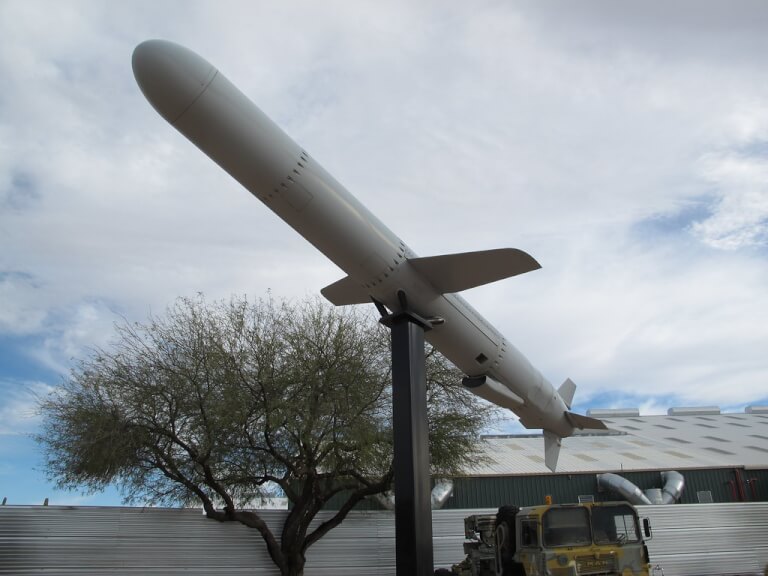
For a fighter plane the tradeoff is much harsher. Less wing means more runway distance to take off and higher landing speeds, which destroys any ability to take off and land from rough fields. They also have a higher corner speed, which is bad, and produce more induced drag for the same turn G’s, which is terrible when avoiding missiles, because it makes them far more vulnerable to follow up shots. Unfortunately, that’s harder to explain to people. Cruise speed being higher is, on the other hand, easy to understand, and easy for politicians to bullshit about.
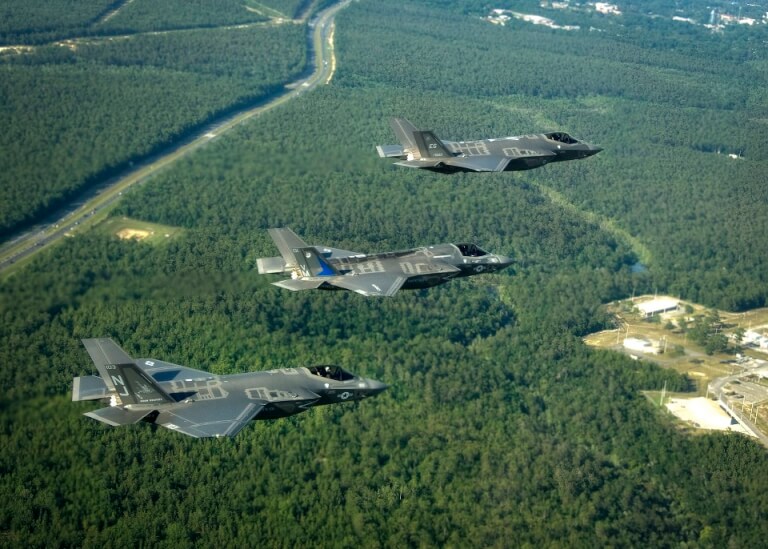
The F-35, pictured above, is one of the best examples of this. They tried to compensate for the horrifically shitty aerodynamic performance by giving the plane a high cruise speed. They even went so far as to destroy the pilots rearwards visibility, which helps them make a more streamlined design.
Except that they fucked up so bad with its slug like draggy body that it can’t do the supercruise it was designed to do anyway. So they paid a high price in terms of turning ability, pilots vision, etcetera, all to get a plane that still can’t even go fast. So Lockheed Martin started bloviating about how it’s a “5th generation fighter,” with “stealth technology,” that makes it totally okay to have the aero performance of a flying brick.

I can’t even recall all the bullshit LM spouted about the F-35. I remember they were bloviating about designing a helmet that could “see through the cockpit,” by relying on cameras installed on the outside of the plane. Way back in the day I got into fights with retards online who thought this shit was actually real, where by real I mean “in any way practical.”
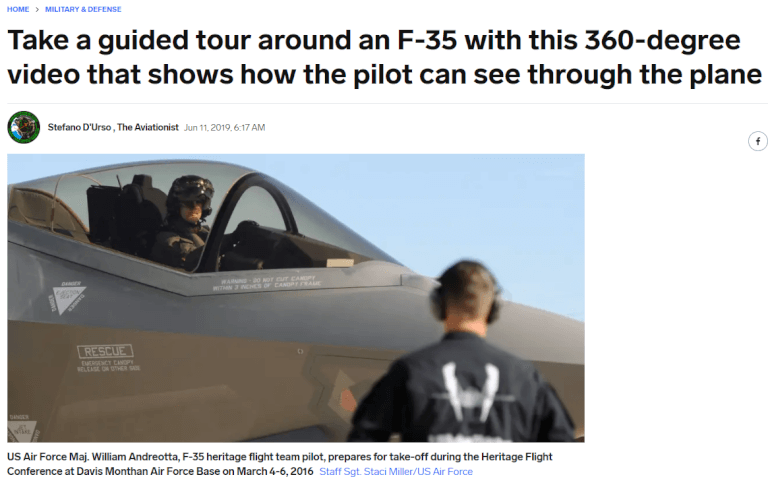
You don’t hear much about that these days, due to a combination of Lockheed Martin not needing to steal your taxdollars – having already stolen them – and a critical mass of pilots who have flown these planes pointing out how fucking garbage that “feature,” is. Which, I might add, anyone with rudimentary knowledge of photography or even just common sense could have figured out in about ten seconds.
In the place of planes that can take off and land from rough fields, and use large, but reasonable amounts of fuel, we get bullshit marketing spew that doesn’t mean anything. And to the extent that there are actually some minor advantages that can be achieved in a larger plane, such as higher cruise speed, or the ability to carry longer range missiles, or a larger radar, these advantages would need to be proven to outweight the serious disadvantages even in a 1:1 fight. Except that it will never be a 1:1 fight in reality, since fuel hungry fighters will be outnumbered many multiple times by smaller, less fuel hungry fighters. Good luck winning a fight outnumbered 5:1.

But I’m getting ahead of myself. In the next installment we finally look at tactical performance, which is the one place where these modern fighter planes aren’t complete and utter jokes. Still bad, mind you, but not jokes. I mean sure, they’re all going to be destroyed on the ground, and even if that didn’t happen, they’d be getting outnumbered by the enemy fighter planes somewhere around 8:1, but they can at least go pretty fast and fire some missiles. So in the next installment we figure out if the crippled fleet size is made up for by some sort of spectacular tactical performance.

Spoiler Warning: it isn’t.

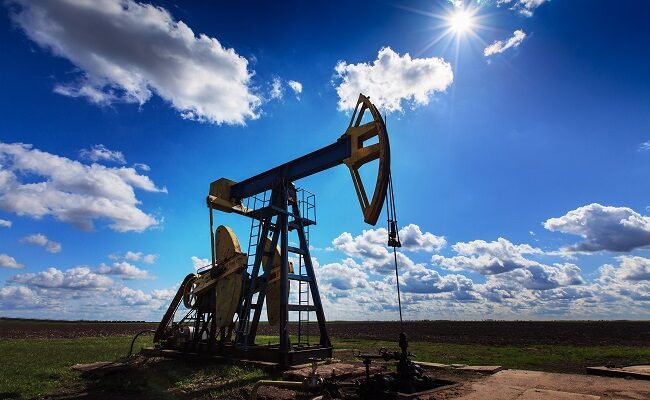
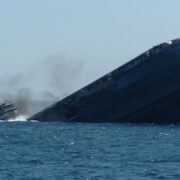













Good article mate, you could’ve skipped the oil wells section and just pointed out that the number of refineries are in the 100s and can be bombed. You should also consider writing an article on the logistical dependence on China and global trade in general. Many parts are imported, or the machines that make the parts are imported. There’s no way those ships/planes/tanks are 100% made in USA.
https://www.cbsnews.com/news/some-us-military-parts-imported-from-china/
https://nationalinterest.org/blog/the-buzz/the-us-militarys-greatest-weakness-china-builds-huge-chunk-25966
https://www.americanmanufacturing.org/blog/americas-military-is-supplied-by-china/
The fact that much of our manufacturing no longer exists in our country is something a serious country would have never in a million years allowed.
Fascinating analysis…
it is, absolutely
Explains why NATO is sitting on its hands: they don’t want to be “Ukrained.” IOW, they don’t want missiles raining down on their airfields and/or refineries.
So it looks like the Russkies have NATO in check; I wonder how long before the alliance falls apart?
Exactly right. I’ll write about this a bit more in a brief piece in between the final installment in the series. NATO basically made the cynical calculation that they wouldn’t be able to justify Russia blowing up their airbases as an act of war if they were shooting down Russian planes.
[…] My “Modern Fighter Planes are Jokes” series was very well received. I hope to find the time to finish it one of these days, but I’m swamped as it is. The most important entries are the first three, where I go over the trivial ease with which these planes can be destroyed on the ground, briefly speak on Aircraft Carriers, and then talked about their ridiculous fuel consumption numbers. […]